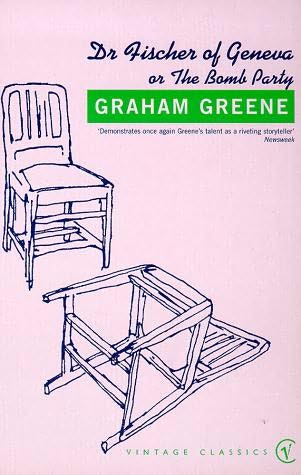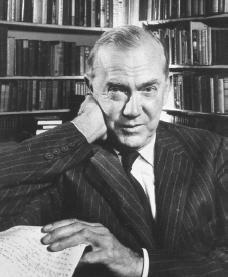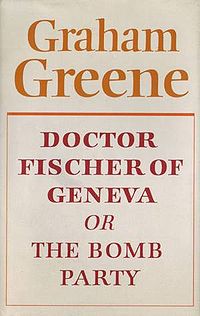This book review was the first thing I ever wrote for The Soho News, a small-time weekly competitor of The Village Voice that I wrote for every week for about a year and a half (1980-81), reviewing books as well as movies on a fairly regular basis. I did 68 pieces for them in all, and this first effort, as I recall, was a kind of trial balloon. — J.R.
The Greening of Switzerland
by Jonathan Rosenbaum
——————————————————-
Doctor Fischer of Geneva or the Bomb Party
By Graham Greene
Simon and Schuster, $9.95
——————————————————-
“The meat is excellent, but I have no appetite,” remarks the noble, grief-stricken narrator of Graham Greene’s opulent 21st novel — plain old Alfred Jones, a middle-class voyeur like us — at the climactic title party, in response to a query from the wealthy title host and villain. Then he adds more confidentially, to the reader, “I helped myself to another glass of Mouton Rothschild; it wasn’t for the flavor of the wine that I drank it, for my palate seemed dead, it was for the distant promise of a sort of oblivion.” The same sort of delicious oblivion, one might add, that we normally expect from a new Greene novel — which is the sort that the latest one amply supplies.
Nobody but nobody offers sexier, more glamorous Catholic guilt than Greene at his best. Thirty years back, George Orwell was already noting that Greene seemed to share the Baudelaire-derived notion that “there is something rather distingué in being damned” whereby “Hell is a sort of high-class nightclub…” That was around the same time that Greene was scripting The Third Man, a thriller whose charismatic, amoral villain, Harry Lime (Orson Welles), was a postwar profiteer trafficking in diluted penicillin in Vienna’s black market. The leering Mr. Lime had a neat way of summing up Switzerland — the ostensibly “neutral” setting of Greene’s latest version of Faust. It occurred in a speech reportedly furnished by Welles himself, who claimed to have copied it from an old Hungarian play.
“In Italy for 30 years under the Borgias they had warfare, terror, murder, bloodshed — they produced Michelangelo, Leonardo da Vinci and the Renaissance. In Switzerland they had brotherly love. 500 years of democracy and peace, and what did that produce? The cuckoo clock.”
Graham Greene, on the other hand, produces metaphysical fairy-tale thrillers about innocence and damnation — which might be described roughly as flirtation contests between the two. And the uncommon pleasure of Doctor Fischer of Geneva or the Bomb Party (only 156 pages long, and I defy you to read them in more than one sitting; lots of snowy landscapes, perfectly timed for hot summer reading) is that it knows exactly what buttons to push to get its sleek effects.
***
Like certain other septuagenarian craftsmen — the Hitchcock of Family Plot, the Bresson of Lancelot of the Lake, or even the Matisse who devoted himself to paper cutouts — Greene is smart enough to realize that all he has to do to is reduce his gestures to irreducible signs, nothing more, and everyone will catch the signals. He can tenderly give his hero an artificial hand to replace the one he lost in the London blitz, bestow his heroine (and her late mother) with a passionate love of Mozart, and virtually the rest of their trembling vulnerability can be sketched in by us, who naturally want to protect them.
Alfred Jones, fiftyish translator for a chocolate factory in Vevey (the fashionable resort of Daisy Miller in the James novella), meets Anna-Luise, twentyish daughter of evil millionaire Dr. Fischer, mysterious inventor of Dentophil Bouquet toothpaste. The rest is artful plotting, casting, and set decoration. And because it’s Greene who’s delicately pulling all the strings, we can be made to believe that it’s genuinely love at first sight — with Alfred becoming the kindly father that Anna-Luise never had, and she becoming both the wife and daughter that he lost in childbirth 20 years before.
Dr. Fischer — playing a sort of elusive giant lemon here in relation to The Third Man‘s Lime (another “natural” cameo part for Welles when the inevitable movie adaptation gets made) — is variously identified with God Almighty and Satan, even by the secular romantic couple, and provides as much gratuitous nastiness as any fairy-tale bogeyman. An embittered sadist who spends most of his visible time humiliating a circle of rich acquaintances at specially planned parties — concocting diverse endurance tests for them to undergo in exchange for lavish presents, in order to demonstrate their unlimited greed and hypocrisy — he registers with a compositional purity rarely found in mortals. A sour version of the artist as frustrated tycoon, he hovers over the action like a malignant presence even when he isn’t around physically, through the cruelty of his deeds.
Greene’s shapely plot is a delight to experience, and none of the game should be given away here. For Greene, plot is character, and the brief portraits sketched above are scarcely more than his narrative starting points. (I’ve omitted the court of grotesques surrounding Fischer at his fancy bashes: already a veritable cast of character actors — including an American widow with blue hair, an alcoholic movie actor, and an international lawyer shaped like the number seven — they line up rather symmetrically in dramaturgical terms, like Twelve Angry Men or the Boys in the Band.)
If, dramatically speaking, the book peaks a few pages before it ends — arguably, a serious flaw in a miniature — this might be due to an odd surfeit of liberal sanity that unexpectedly overtakes Greene’s apocalyptic fantasy at the last minute. Mutatis mutandis, it’s a little bit like calling in Kurt Vonnegut Jr. to write an epilogue to Sophie’s Choice. But Greene can be forgiven for diluting his splendid nonsense with sense and trafficking in bromides, for he wants to let us off easy. How can we find it in our hearts to refuse him?
— The Soho News, May 14, 1980



